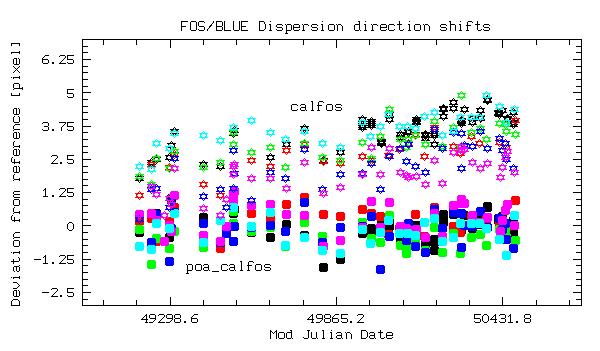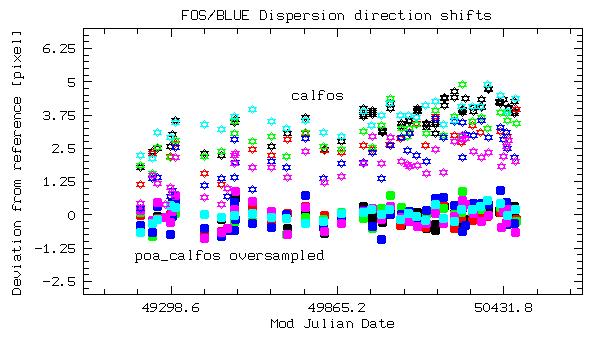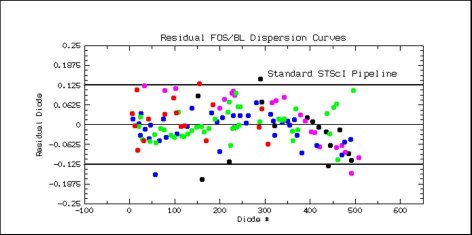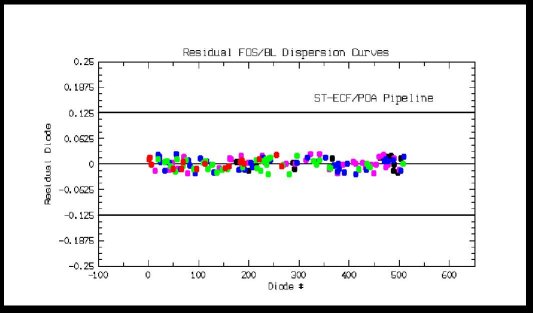|
POA: Zero Points of FOS/BLUE Wavelength Scales with POA_CALFOS
|
ST-ECF |
|
 Zero points rectified
with POA_CALFOS V1.0 (and subsequent versions): Zero points rectified
with POA_CALFOS V1.0 (and subsequent versions):
The electron beam in the FOS detectors drifted about on short and long
time scales as a result of several different error sources (
Update to HST Data Hand Book: Offset correction ). On the FOS/BLUE
side the net effect was a drift almost linear in time away from the
original reference grid for the wavelength calibration. Superimposed
on this long term trend is an uncertainty band of approximately ±
2 pixels. The zero points of the various grating modes were affected
differently because of differences in the electronic setup values.
For about 250 FOS/BLUE wavelength calibration exposures obtained between
April 1993 and Jan 1997 this pattern is shown here with star symbols.
Different gratings are indicated by the rainbow colors (G130H black,
G190H purple, G270H blue, G400H green, G570H red and G650L cyan). The
data were obtained by cross-correlating these exposures with the ones
that had been used to generate the dispersion solutions of the FOS pipeline.

POA_CALFOS V1.0/1.1 (filled symbols) restores the zero points of
the wavelength calibration to the original (design) uncertainty level
of ± 1 pixel, or 50 km/sec for FOS/BLUE side data obtained in SPECTROPHOTOMETRY
(ACCUM, RAPID READOUT and IMAGE) mode.
 Zero
points rectified with over-sampled POA_CALFOS: Zero
points rectified with over-sampled POA_CALFOS:
In order to remain consistent with the philosophy of CALFOS the correction
in the released versions of POA_CALFOS (v1.0 onwards) is applied in
integer pixel steps only. Over-sampled versions of the calibrated spectra
would preserve the accuracy of the corrective algorithm and thereby
lead to a further factor of 2 reduction in the wavelength uncertainty,
as can be seen in the following plot (symbols as above). Users may use
the 'pfos_pix2wav' task
in the IRAF STPOA package to find the sub-pixel correction applicable
to and resulting wavelength for a table of pixel positions from any
given FOS BLUE observation.

The impact on science data can already be estimated from the above
diagrams. In order to check on your pet data set you need the Modified
Julian Date (MJD) of the exposure, which can be obtained from the data
header keyword FPKTTIME. MJD 49299 is in Nov 93, 49865 in May 95, and
50432 in Dec 96. A test science case recalibrated with POA_CALFOS is
discussed .. here .. .
 FOS/BL
Dispersion Relation - calfos FOS/BL
Dispersion Relation - calfos
In the first figure the data is reduced using CALFOS, which in this
context means:
- Third order polynomial to describe each grating separately
- Incomplete, inaccurate list of lines (PtCr-Ne lamp)
- G130H never properly calibrated, scattered light

In the second figure POA_CALFOS was used, i.e.:
- Physical model of optical path aperture-diode array
- All gratings described by same set of parameters
- Improved line list for Pt-Ne lamp & Cr data (NIST)

POA | ESA | NASA
| ST-ECF Archive |
ESO | ST-ECF | STScI
| Search
|
![[STECF HOME]](/logo/stecfwhite.gif)
![[STECF HOME]](/logo/stecfwhite.gif)